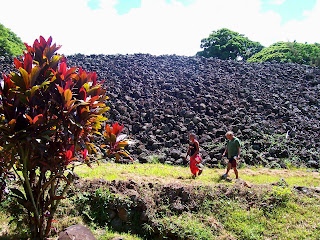
“Cock-a-doodle-do!”
‘Cock-a-doodle do?’ I thought to myself. ‘There must be some mistake. ‘ It had, indeed, been one of those peculiar days when the negative ions had been running amok since breakfast and things were more bizarre than usual. I looked around for said fowl, and seeing none, I proceeded to let the door shut behind me. I noted the slots for outgoing mail directly in front of me, turned 90 degrees to my right and spotted a long line of silver mailboxes, turned another 90 degrees and saw a display of packaging material and a tall metal waste basket. Someone had swiped the pen from the chain attached to the counter—again. It looked like I was standing in the middle of the post office all right, but just to make sure, I went back outside and looked at the sign on the side of the building: Airport Branch, United States Postal Service. Thus assured, I opened the door again.
“Cock-a-doodle-do!”
This time the cry came a little fainter--from the back of the chicken coop—I mean, the package handling area. The other people standing in line didn’t seem to be bothered by the rooster chorus, so I shrugged it off. Still, I wasn’t completely convinced that I hadn’t somehow mistakenly opened the door to the back of the barn. I surveyed the postal workers behind the long counter, each at their appointed cubical, carrying on as if there was nothing out of the ordinary—as if it was just another day of selling stamps, and handling packages coming and going…
“Cock-a-doodle-do!”
Through the very door I had just entered came a large crate, “Live animal” lettered on the side of the cardboard box. Two beady eyes peered through the air holes of the crate. Below the crate, an extended paunch, a precarious place for balancing said crate, but utilized to the fullest, nonetheless. Beneath the paunch, two stubby legs ended in a pair of black zori slippers. Junior Boy, obviously an old hand at this maneuver, swung the crate around and hefted it up on the postal scale in one smooth motion.
“Cock-a-doodle-do!”
From my place in line, I could look behind the cashier and see a cart with several crates lined up, and gauging from the racket, all filled with roosters. The bird on the scale pecked at the side of his carton, desperate to escape the dark prison of cardboard, threatening to get at his brethren and tear them to shreds.
“Cock-a-doodle-do—you son of a bitch. If I ever get out of this joint and get my hands on you I’ll….”
“You and who else?” The second bird answered.
From the back room came a muffled, “Who’s your muther?”
Junior Boy made a hasty retreat through the door and left the handling of the bill to an older man. Uncle Junior wore a sleeveless t-shirt with the logo Club Femme Nude on the back. It might as well have said, “Live animal,” the same as the crate, because the logo of a naked lady, her legs curled around a stripper pole, spoke volumes as to the character of the establishment. Birds of a feather, as it were. Uncle Junior expertly handled the monetary end of the transaction, making sure that he rested his hands under the crate at an angle the postal worker couldn’t see and ever so slightly tipping the crate and rooster up in order to subtract a few ounces from the weight of the bird, as if the weighing in of the rooster equated a prize fighter being weighed before a match. For, in truth, that is exactly what was happening—these birds had been bred for one of the island’s national pastimes: cockfighting. Legally, the birds could be shipped for breeding purposes, but honestly, Uncle Junior and Junior Boy didn’t look like they’d seen the sunny side of the law for years—indeed, Junior Boy was learning from an old pro.
“Cock-a-doodle-do!”
Junior Boy brought in yet another crate. Uncle Junior parked his fingers in just the right spot, the postal clerk weighed the bird, and the roosters (none plucked for eating) piled up higher and higher in the back room. I bought my stamps, hoping I could get out before one of the workers (a very long afternoon stretching out in front of them) went postal. What can I say?
“Cock-a-doodle-do!”
It’s just another day in Hilo…..





















